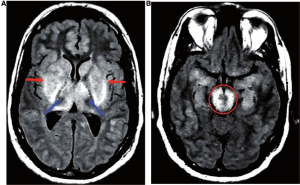Summary
Eastern Equine Encephalitis or sometimes called Triple E is an extremely rare infection that is spread by mosquitoes and birds that are infected with Eastern Equine Encephalitis virus. Eastern Equine Encephalitis can only spread to humans from the bite of a mosquito. It most commonly occurs in the Eastern United States. It a part of the genus Alphavirus within the family Togaviridae. One-third of people who develop EEE die. The ones that do survive will have severe permanent neurologic damage and will die within a few years. There is no treatment for this virus available so avoidance of these mosquitoes is encouraged.
Fact Table
| Formal binomial name of microbe: | Genus: Alphavirus
Family:Togaviridae Mosquito:Culiseta melanura |
| Gram stain (gram positive, gram negative or neither): | Neither |
| Is the microbe mobile or immobile? | Mobile |
| Primary habitat? (Where is the organism normally found or prefer to live?) | -Mainly arthropods but are also found in animals and humans host cells
-Swamp areas |
| Can the organism infect humans? | Yes |
| Can the organism infect other species? If so, which ones. | Yes, pigs, llamas, bats, reptiles, amphibians, rodents, horses, donkeys, birds, and flies |
| Documented cases of antimicrobial resistance? | All, antibiotics are not effective |
| Number of infections per year in the US | Average of 7 human cases |
| Number of infections per year in the world | Only found in the Eastern United States |
Description
Eastern Equine Encephalitis is spread through mosquitoes called Culiseta melanura found in swampy wetlands. They are divided into 3 segments, the head, abdomen, and thorax. The abdomen is divided into 10 segments. The head includes the antennae, eyes, palpi, and proboscis. Below is a picture of the Culiseta melanura that cause the virus.


Eastern Equine Encephalitis happens within 4 to 10 days after a mosquito bite. There are 2 different types of illnesses, systemic and encephalitic. The type of lines depends on the age of the person and host factors. Encephalitic involves brain inflammation and systemic is an illness that lasts 1 to 2 weeks. Some symptoms of systemic are chills, fever, pain in the joints, and muscle pain. Recovery can be achieved because there is no central nervous system involvement. Signs and symptoms of encephalitis are fever, restlessness, headaches, cyanosis, coma, vomiting, and diarrhea. Encephalitic illness is much harder to recover from because it involves the brain. Healthcare providers test cerebrospinal fluid to find out if someone has Eastern Equine Encephalitis. Some findings are neutrophil-predominant pleocytosis and elevated protein levels. The second picture above is an MRI of the brain of someone who has Eastern Equine Encephalitis. There is hyperintensity in the bilateral basal ganglia and the brain stem.
New Articles
Two Eastern Equine Encephalitis infected mosquitoes were found in swamps in New York and Massachusetts. You can avoid these mosquitoes by using bug spray with DEET and lemon eucalyptus. Health officials also recommend getting rid of standing water.
18 horses in Florida were infected with the Eastern Equine Encephalitis virus. The mortality rate in horses of Eastern Equine Encephalitis is 90%. It’s worse than the West Nile virus which has a mortality rate of 30%.
“Eastern equine encephalitis in Florida horses: 18 cases to date”
Researchers said that Eastern Equine Encephalitis virus was spread through a solid organ transplant. Statistics show that 3 people who received organ transplants received the virus within 1 week of transplantation. The virus contributed to one of the deaths of the organ recipients.
“Eastern equine encephalitis transmitted via solid organ transplantation”
References
“Eastern (Western) equine encephalitis virus”;MSDSonline;
“Eastern Equine Encephalitis”;Centers for Disease Control and Prevention;
https://www.cdc.gov/easternequineencephalitis/gen/qa.html
“Eastern Equine Encephalitis(EEE)”;Department of Health;
https://www.health.ny.gov/diseases/communicable/eastern_equine_encephalitis/fact_sheet.htm